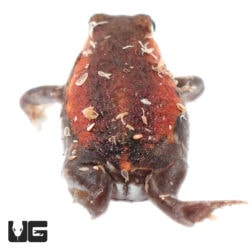Rain Frog for Sale: Unlock the Beauty of Nature with Your Own Amphibian Buddy!
Rain Frog for Sale: Unlock the Beauty of Nature with Your Own Amphibian Buddy!
Blog Article
The Most Effective Reptile Enclosures: Just How to Create the Suitable Habitat
Developing the best habitat for reptiles is not almost positioning them in a container or enclosure; it includes a thoughtful factor to consider of different aspects that contribute to their overall wellness. From the size of the enclosure to the type of substrate made use of, every aspect plays an important function in giving an atmosphere where your reptile can prosper. By recognizing the certain requirements of your reptile varieties and carrying out the appropriate habitat arrangement, you can guarantee their health and happiness in captivity.
Choosing the Right Room Size
When choosing a room size for reptiles, it is essential to consider their all-natural actions and room demands to guarantee their health and health. When it comes to habitat room, various reptile types have varying requirements. Arboreal types like chameleons or tree serpents call for upright space for climbing and perching, while earthbound types such as bearded dragons or leopard geckos require more flooring space for exploring and thermoregulation. Aquatic turtles like red-eared sliders require units with both water and acreage for swimming and basking.
A basic rule of thumb is to give ample room for the reptile to display all-natural habits, such as basking, concealing, climbing, and foraging. By very carefully taking into consideration the particular demands of the reptile varieties in question, owners can produce a suitable and improving habitat that advertises overall health and urges all-natural habits.
Setting Up Proper Burner
To make certain the wellness and health of reptiles in their enclosures, it is vital to thoroughly establish up proper burner. Reptiles are ectothermic creatures, implying they depend on outside heat sources to regulate their body temperature level. When establishing home heating elements in a reptile unit, it is crucial to think about the specific temperature requirements of the varieties you are caring for. Different reptiles have varying temperature requires based on their all-natural environment, so it is very important to research study and recognize these requirements.
One usual and effective burner for reptile units is a warmth light or ceramic heat emitter. These warm sources can be utilized to develop a temperature gradient within the enclosure, enabling reptiles to move between warmer and cooler locations as required. Additionally, under-tank hot pad or warmth mats can be used to offer stubborn belly warm, which is particularly valuable for reptiles that need added warmth to assist in food digestion.
Keeping an eye on the temperature within the enclosure making use of a thermometer is necessary to make certain that the burner are preserving the suitable temperature level variety for your reptile. Routinely examine and readjust the heating aspects as needed to develop a comfortable and healthy setting for your scaly friend.
Choosing Appropriate Lights Components

Supplying the Ideal Substrate
Selecting the proper substrate is important for creating a appropriate and comfy environment for reptiles in their units. The substrate offers different purposes, consisting of offering a foundation for all-natural actions like delving, assisting in maintaining ideal humidity levels, and offering a comfortable surface for the reptile to relax upon - rain frog for sale. When picking a substratum for your reptile unit, it is essential to consider the species-specific demands of your animal. Some reptiles, such as desert-dwelling varieties like bearded dragons, flourish on substrates like calcium sand or reptile carpet, while others, like ball pythons, like coconut husk over at this website or aspen bedding to preserve humidity degrees.
Avoid substrates that can create impaction, such as loose substrates like sand or gravel, particularly for reptiles known to consume their bedding. On a regular basis cleaning and replacing the substratum is vital to make sure a clean and hygienic atmosphere for your reptile.
Decorating for Enrichment and Comfort
Taking into consideration the substratum's duty in supplying a foundation for natural habits and preserving a suitable atmosphere, improving the reptile enclosure with appropriate designs is vital for both enrichment and convenience. Designs such as branches, rocks, hideouts, and synthetic plants not just produce an extra aesthetically attractive environment yet also serve useful purposes. Branches supply climbing chances for arboreal types, while rocks can serve as basking areas for heat. Hideouts use shelter and protection, decreasing tension levels for the reptile. Artificial plants not just boost the aesthetic appeals yet additionally give concealing areas and enrichment other by enabling the reptile to check out and communicate with its setting. When enhancing the room, it is necessary to think about the reptile's species-specific needs and habits to develop a space that promotes physical and mental well-being. By including a range of designs that resemble the reptile's natural habitat, owners can guarantee their animal's convenience and stimulate their all-natural impulses, ultimately leading to a better and healthier reptile.
Verdict

Creating the best environment for reptiles is not simply regarding putting them in a storage tank or enclosure; it includes a thoughtful consideration of various aspects that add to their overall wellness.Choosing the ideal substratum is vital for creating a comfy and appropriate atmosphere for reptiles in their enclosures. Some reptiles, such as desert-dwelling varieties like bearded dragons, prosper on substratums like calcium sand or reptile carpet, while others, like round pythons, choose coconut husk or aspen bed linen to preserve moisture levels.
By including a variety of decorations that simulate the reptile's natural environment, proprietors can ensure their pet's comfort and boost their natural impulses, eventually leading to a better and healthier reptile.
In conclusion, creating the excellent environment for reptiles entails choosing the suitable room dimension, home heating aspects, lighting fixtures, substrate, and decorations.
Report this page